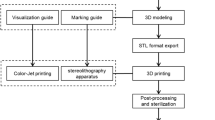Abstract
Physician-modified endovascular grafts (PMEGs), with fenestrations added to accommodate major branch vessels, provide a means for endovascular treatment of juxta-renal abdominal aortic aneurysms. Manual measurements of vessel origin locations from computed tomography images, however, take time and can lead to errors in the positions of the fenestrations. To make the fenestration process faster and more accurate, we have developed a procedure to create custom templates that serve as patient-specific guides for graft fenestration. We use a three-dimensional printer to create a clear rigid sleeve that replicates the patient’s aorta and includes holes placed precisely at the locations of the branch vessels. The sleeve is placed over the graft, the locations of the openings are marked with a sterile pen, and the fenestrations are created after the sleeve is removed. Custom fenestration templates can potentially save procedural costs and make minimally invasive aortic aneurysm repair available to many more patients. This chapter summarizes the 3D printing applications to create models for preoperative planning of PMEGs.
Access this chapter
Tax calculation will be finalised at checkout
Purchases are for personal use only
Similar content being viewed by others
References
United Kingdom EVAR Trial Investigators, Greenhalgh RM, Brown LC, Powell JT, Thompson SG, Epstein D, Sculpher MJ. Endovascular versus open repair of abdominal aortic aneurysm. N Engl J Med. 2010;362:1863–71.
Schanzer A, Greenberg RK, Hevelone N, Robinson WP, Eslami MH, Goldberg RJ, et al. Predictors of abdominal aortic aneurysm sac enlargement after endovascular repair. Circulation. 2011;123:2848–55.
Higashiura W, Nagata T, Tabayashi N, Itoh H, Sakaguchi S, Taniguchi S, et al. Initial experience of branched endovascular graft for abdominal aortic aneurysm with complex anatomy of proximal neck: planning and technical considerations. Jpn J Radiol. 2010;28:66–74.
Nordon IM, Hinchliffe RJ, Manning B, Ivancev K, Holt PJ, Loftus IM, et al. Toward an “off-the-shelf” fenestrated endograft for management of short-necked abdominal aortic aneurysms: an analysis of current graft morphological diversity. J Endovasc Ther. 2010;17:78–85.
Resch T, Sonesson B, Malina M. Incidence and management of complications after branched and fenestrated endografting. J Cardiovasc Surg (Torino). 2010;51:105–13.
Starnes BW. Physician-modified endovascular grafts for the treatment of elective, symptomatic, or ruptured juxtarenal aortic aneurysms. J Vasc Surg. 2012;56:601–7.
Starnes BW, Tatum B. Early report from an investigator-initiated investigational device exemption clinical trial on physician-modified endovascular grafts. J Vasc Surg. 2013;58:311–7.
Legget ME, Leotta DF, Bolson EL, McDonald JA, Martin RW, Li XN, et al. System for quantitative three dimensional echocardiography of the left ventricle based on a magnetic field position and orientation sensing system. IEEE Trans Biomed Eng. 1998;45:494–504.
Causey MW, Jayaraj A, Leotta DF, Paun M, Beach KW, Kohler TR, et al. Three-dimensional ultrasonography measurements after endovascular aneurysm repair. Ann Vasc Surg. 2013;27:146–53.
Leotta DF, Primozich JF, Beach KW, Bergelin RO, Strandness Jr DE. Serial measurement of cross-sectional area in peripheral vein grafts using three-dimensional ultrasound. Ultrasound Med Biol. 2001;27:61–8.
Author information
Authors and Affiliations
Corresponding author
Editor information
Editors and Affiliations
Rights and permissions
Copyright information
© 2017 Mayo Foundation for Medical Education and Research
About this chapter
Cite this chapter
Starnes, B.W., Leotta, D.F. (2017). 3D Printing to Create Templates for Patient-Specific Fenestrated Stent Grafts. In: Oderich, G. (eds) Endovascular Aortic Repair. Springer, Cham. https://doi.org/10.1007/978-3-319-15192-2_9
Download citation
DOI: https://doi.org/10.1007/978-3-319-15192-2_9
Published:
Publisher Name: Springer, Cham
Print ISBN: 978-3-319-15191-5
Online ISBN: 978-3-319-15192-2
eBook Packages: MedicineMedicine (R0)




